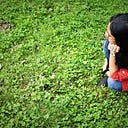In Delhi: Raisina Hill and Gandhi Smriti
Visuals from Republic Day this morning brought me back to a city I’ve learnt to adore. (Disclaimer: I’ve spent a total of about ten days there recently, all in the safe company of friends and family.)
G. and I went properly touristy during our stay in Delhi with his cousins. We thoroughly enjoyed our wanderings through Lutyens’ Delhi, peering at the name-boards in front of palatial houses, trying to match names to ministries or shenanigans. We lost ourselves in the crowds at India Gate, as the sun set and the tricolour lit the top of the monument. Another day, we walked along Rajpath, going up the slope of Raisina Hill to look at Rashtrapati Bhavan, a secure fortress far behind the gates. Across from it, the Secretariat buildings rose in their brown and red sandstone glory, flanked by guards and the police. The quiet of the hill, the utter absence of crowds, was almost startling.
There was a sense of grandeur about the scene that few places in India seem to match. Today, watching the massive floats that filled the screen, I can’t think of many cities with such sweeping roads cutting through their centres. The British laid careful plans for their capital, but didn’t foresee what was to come. Being here, on Raisina Hill, you sense the convergence of history and power, and an enormous amount of gratitude for the people who fought to give you your freedom. Then, you feel a pang of regret for what we could achieve, and where we really are.
***
I don’t know much about Gandhi except what we studied at school. One of the standard essay topics in Hindi exams was “Mera Priya Neta” (My Favourite Leader), and because Nehru and Gandhi were the ones featured in the book, we religiously wrote about them. The Nehru essay was slightly longer than the Gandhi one, so the latter was usually my choice.
Starting with his birth at Porbandar in 1869, to his journey to South Africa and subsequent return to India, where, for our generation, he became the face of the Independence movement, the essay was a superficial look at his life and times. We learnt little more in our history textbooks. For some reason, I never tried to read about Gandhi later and took for granted what the textbooks said. As a result, Birla House (Gandhi Smriti) was not on my itinerary.
However, we ended up making an unplanned stop there and I’m glad I went. The manicured lawns of Birla House caught the light of the setting sun, as did the spotless room furnished sparsely with Gandhi’s cot and desk. History came alive as we walked down the path he took to attend the prayer meeting, culminating in a memorial where he was shot. Birla House was where Gandhi spent his last months, the time when India gained independence and struggled through Partition.
Even as I fought tears during the visit, I realised I needed to know more about Gandhi. To me, he was an enigmatic character, because how can one be human, in the middle of a raging storm, and still call for non-violence?
I plan to read Josephy Lelyveld’s book, Great Soul: Mahatma Gandhi and his Struggle for India. It caused controversy when it came out, but I am keen to see what Lelyveld has to say. (Ramachandra Guha is probably the most obvious starting point on Gandhi, but this was just more handy, so why not?) Our textbooks told us about Gandhi’s work for peace and equality. But he was clearly not born with all the qualities that he is widely revered for. He said as much himself:
I deny being a visionary. I do not accept the claim of saintliness. I am of the earth, earthy … I am prone to as many weaknesses as you are. But I have seen the world. I have lived in the world with my eyes open.
Gandhi has been variously called shrewd, racist, saintly, and a host of other adjectives. So what made him who he was? Who was he?
My attention span being what it is, I’ll be happy to make decent progress on this book. Happily, I finished my first book for the year today: Around India in 80 Trains. It was an easy read, but not extraordinary. There wasn’t much that was new and I definitely wish it had more depth. But it kept me company when I was struggling to focus, gave me something to look forward to in the form of multiple train journeys across the country, and for that reason alone, I’ll be eternally grateful to Monisha Rajesh. Hopefully, it will help me ease into my next book.
